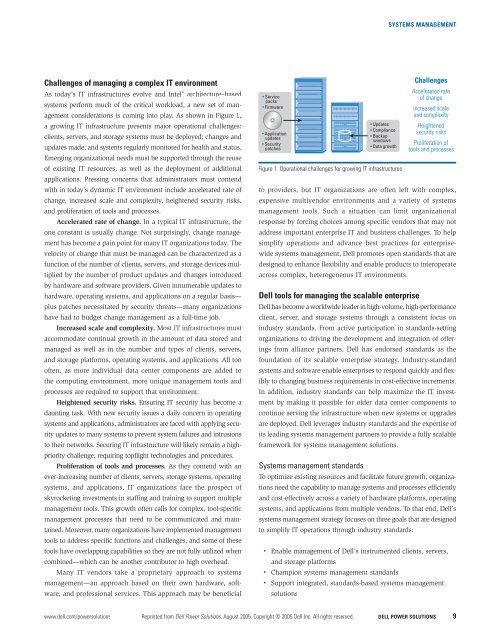POWER SOLUTIONS
POWER SOLUTIONS
POWER SOLUTIONS
You also want an ePaper? Increase the reach of your titles
YUMPU automatically turns print PDFs into web optimized ePapers that Google loves.
SYSTEMS MANAGEMENTChallenges of managing a complex IT environmentAs today’s IT infrastructures evolve and Intel ® architecture–basedsystems perform much of the critical workload, a new set of managementconsiderations is coming into play. As shown in Figure 1,a growing IT infrastructure presents major operational challenges:clients, servers, and storage systems must be deployed; changes andupdates made; and systems regularly monitored for health and status.Emerging organizational needs must be supported through the reuseof existing IT resources, as well as the deployment of additionalapplications. Pressing concerns that administrators must contendwith in today’s dynamic IT environment include accelerated rate ofchange, increased scale and complexity, heightened security risks,and proliferation of tools and processes.Accelerated rate of change. In a typical IT infrastructure, theone constant is usually change. Not surprisingly, change managementhas become a pain point for many IT organizations today. Thevelocity of change that must be managed can be characterized as afunction of the number of clients, servers, and storage devices multipliedby the number of product updates and changes introducedby hardware and software providers. Given innumerable updates tohardware, operating systems, and applications on a regular basis—plus patches necessitated by security threats—many organizationshave had to budget change management as a full-time job.Increased scale and complexity. Most IT infrastructures mustaccommodate continual growth in the amount of data stored andmanaged as well as in the number and types of clients, servers,and storage platforms, operating systems, and applications. All toooften, as more individual data center components are added tothe computing environment, more unique management tools andprocesses are required to support that environment.Heightened security risks. Ensuring IT security has become adaunting task. With new security issues a daily concern in operatingsystems and applications, administrators are faced with applying securityupdates to many systems to prevent system failures and intrusionsto their networks. Securing IT infrastructure will likely remain a highprioritychallenge, requiring topflight technologies and procedures.Proliferation of tools and processes. As they contend with anever-increasing number of clients, servers, storage systems, operatingsystems, and applications, IT organizations face the prospect ofskyrocketing investments in staffing and training to support multiplemanagement tools. This growth often calls for complex, tool-specificmanagement processes that need to be communicated and maintained.Moreover, many organizations have implemented managementtools to address specific functions and challenges, and some of thesetools have overlapping capabilities so they are not fully utilized whencombined—which can be another contributor to high overhead.Many IT vendors take a proprietary approach to systemsmanagement—an approach based on their own hardware, software,and professional services. This approach may be beneficial• Servicepacks• Firmware• Applicationupdates• SecuritypatchesFigure 1. Operational challenges for growing IT infrastructuresto providers, but IT organizations are often left with complex,expensive multivendor environments and a variety of systemsmanagement tools. Such a situation can limit organizationalresponse by forcing choices among specific vendors that may notaddress important enterprise IT and business challenges. To helpsimplify operations and advance best practices for enterprisewidesystems management, Dell promotes open standards that aredesigned to enhance flexibility and enable products to interoperateacross complex, heterogeneous IT environments.Dell tools for managing the scalable enterpriseDell has become a worldwide leader in high-volume, high-performanceclient, server, and storage systems through a consistent focus onindustry standards. From active participation in standards-settingorganizations to driving the development and integration of offeringsfrom alliance partners, Dell has endorsed standards as thefoundation of its scalable enterprise strategy. Industry-standardsystems and software enable enterprises to respond quickly and flexiblyto changing business requirements in cost-effective increments.In addition, industry standards can help maximize the IT investmentby making it possible for older data center components tocontinue serving the infrastructure when new systems or upgradesare deployed. Dell leverages industry standards and the expertise ofits leading systems management partners to provide a fully scalableframework for systems management solutions.Systems management standardsTo optimize existing resources and facilitate future growth, organizationsneed the capability to manage systems and processes efficientlyand cost-effectively across a variety of hardware platforms, operatingsystems, and applications from multiple vendors. To that end, Dell’ssystems management strategy focuses on three goals that are designedto simplify IT operations through industry standards:• Enable management of Dell’s instrumented clients, servers,and storage platforms• Champion systems management standards• Support integrated, standards-based systems managementsolutions• Updates• Compliance• Backupwindows• Data growthChallengesAccelerated rateof changeIncreased scaleand complexityHeightenedsecurity risksProliferation oftools and processeswww.dell.com/powersolutions Reprinted from Dell Power Solutions, August 2005. Copyright © 2005 Dell Inc. All rights reserved. DELL <strong>POWER</strong> <strong>SOLUTIONS</strong> 9








